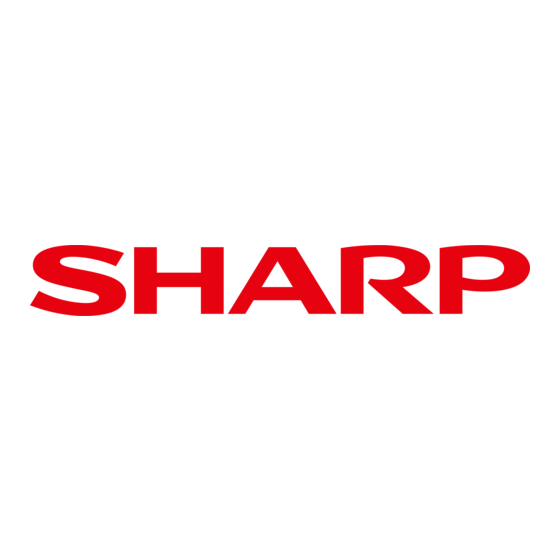Sharp CAROUSEL R-303T Manual de operação - Página 6
Procurar online ou descarregar pdf Manual de operação para Forno micro-ondas Sharp CAROUSEL R-303T. Sharp CAROUSEL R-303T 16 páginas. Sharp microwave oven user manual

I N F O R M A T I O N Y O U N E E D T O K N O W
UTENSILS GUIDE
This section lists which utensils can be used in the mi-
crowave, which ones have limited use for short periods,
and which ones should not be used in the microwave.
RECOMMENDED
Microwave browning dish — Use to brown the exte-
rior of small items such as steaks, chops, or pancakes.
Follow the directions provided with your browning dish.
Microwaveable plastic wrap — Use to retain steam.
Leave a small opening for some steam to escape and
avoid placing it directly on the food.
Paper towels and napkins — Use for short-term heat-
ing and covering; these absorb excess moisture and
prevent spattering. Do not use recycled paper towels,
which may contain metal and could ignite.
Glass and glass-ceramic bowls and dishes — Use
for heating or cooking.
Paper plates and cups — Use for short-term heating
at low temperatures. Do not use recycled paper, which
may contain metal and could ignite.
Wax paper — Use as a cover to prevent spattering.
thermometers — Use only those labeled "Microwave
Safe" and follow all directions. Check the food in sev-
eral places. Conventional thermometers may be used
on microwave food once the food has been removed
from the oven.
LIMITED USE
Aluminum foil — Use narrow strips of foil to prevent
overcooking of exposed areas. Using too much foil can
damage your oven, so be careful. You should keep
distance of 1 inch (2.54cm) between aluminum foil and
cavity.
Ceramic, porcelain, and stoneware — Use these
if they are labeled "Microwave Safe". If they are not
labeled, test them to make sure they can be used safely.
Plastic — Use only if labeled "Microwave Safe". Other
plastics can melt.
Not Recommended
Glass jars and bottles — Regular glass is too thin
to be used in a microwave. It can shatter and cause
damage and injury.
Paper bags — These are a fire hazard, except for
popcorn bags that are designed for microwave use.
Styrofoam plates and cups — These can melt and
leave an unhealthy residue on food.
Plastic storage and food containers — Containers
such as margarine tubs can melt in the microwave.
Metal utensils — These can damage your oven. Re-
move all metal before cooking.
Note:
Should you wish to check if a dish is safe for microwav-
ing, place the empty dish in the oven and microwave on
HIGH for 30 seconds. A dish which becomes very hot
should not be used.
COOKING TECHNIQUES
Your microwave makes cooking easier than conven-
tional cooking, provided you keep these considerations
in mind:
STIRRING
Stir foods such as casseroles and vegetables while
cooking to distribute heat evenly. Food at the outside of
the dish absorbs more energy and heats more quickly,
so stir from the outside to the center. The oven will turn
off when you open the door to stir your food.
ARRANGEMENT
Arrange unevenly shaped foods, such as chicken
pieces or chops, with the thicker, meatier parts toward
the outside of the turntable where they receive more
microwave energy. To prevent overcooking, place deli-
cate areas, such as asparagus tips, toward the center
of the turntable.
SHIELDING
Shield food with narrow strips of aluminum foil to prevent
overcooking. Areas that need shielding include poultry
wing tips, the ends of poultry legs, and corners of square
baking dishes. Use only small amounts of aluminum foil.
Larger amounts can damage your oven.
TURNING
Turn foods over midway through cooking to expose all
parts to microwave energy. This is especially important
with large foods such as roasts.
STANDING
Foods cooked in the microwave build up internal heat
and continue to cook for a few minutes after heating
stops. Let foods stand to complete cooking, especially
foods such as cakes and whole vegetables. Roasts
need this time to complete cooking in the center without
overcooking the outer areas. All liquids, such as soup or
hot chocolate, should be shaken or stirred when cooking
is complete. Let liquids stand a moment before serving.
When heating baby food, stir well at removal and test
the temperature before serving.
ADDING MOISTURE
Microwave energy is attracted to water molecules. Food
that is uneven in moisture content should be covered
or allowed to stand so that the heat disperses evenly.
Add a small amount of water to dry food to help it cook
6
